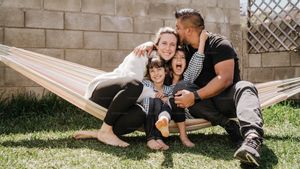JAKARTA - The government is asked to move quickly and strategically. The public is also advised to be vigilant following the positive confirmation of the three latest COVID-19 cases, the Indian strain, B.1.6.1.7 and the British strain, B.1.1.7 in Banten. What is this virus like? How dangerous? What are the symptoms and where have they spread so far?
Head of the Banten Provincial Health Office, Dr. Ati Pramudji Hastuti, revealed one case of exposure to B.1.1.7 British strain in Mekar Baru District, Tangerang Regency. Meanwhile, two cases of B.1.6.1.7 Indian strain were in North Serpong District, South Tangerang City.
Ati explained that two patients in South Tangerang were exposed to the Indian strain of the corona virus from their son who lives in Jakarta. Meanwhile, the patient in Tangerang contracted the British coronavirus strain from his trip to Saudi Arabia.
Two South Tangerang patients are currently being treated at the Hermina Hospital. Meanwhile, "the case in Tangerang Regency is undergoing special isolation, under the supervision of the Puskesmas because it has mild symptoms," said Ati, Wednesday, May 5.
The spread of the new variant of the corona virus in IndonesiaTuesday, May 4, the Ministry of Health announced a number of new variants of the corona virus that had entered Indonesia. Yes, there are B.1.1.7 British strains, B.1.6.1.7 Indian strains, and B.1.3.5.1 South African (South African) strains.
Vaccination spokesperson for the Ministry of Health, Dr. Siti Nadia Tarmizi, said that these three strains had caused the spike in COVID-19 cases in several countries around the world. Nadia mentioned human mobility as the cause of the spread of the three variants.

"There are three types of variants that are classified as Varian of Concern or VoC, namely B.117, B.1351, and variant B1617. "This variant B.117 is known to have a higher transmission rate of around 36 to 75% compared to the previously circulating virus," he said, in a virtual press conference, Tuesday, May 4.
The British variant, B.1.1.7 is the most widely reported country in the world. The World Health Organization (WHO) recorded an increase in cases of up to 49 percent related to the circulation of variant B.1.1.7 in Southeast Asia.
The Ministry of Health website details the distribution of the three variants of the corona virus in Indonesia.
Variant type B.1.6.1.7: One case in Riau Islands and one case in DKI Jakarta Variant type B.1.1.7: Two cases in North Sumatra, one case in South Sumatra, Banten (1 case), West Java (5) , East Java (1), Bali (1), East Kalimantan (1) Type variant B.1.3.5.1: One case in Bali.
Indian strain
A professor from Gentik's School of Epidemiology at King's College, London, UK discovered a specific symptom of the Indian strain of COVID-19: skin rash. The skin rash is found in one in five people who catch the Indian strain of COVID-19.
In addition, there are other, more common symptoms, namely:
Sore Throat Fatigue Pain in Body Parts Fever and Chills Nausea and Vomiting Dizziness No saliva.British strains
Corona virus B.1.1.7 which is a British strain is known to be more contagious by up to 50 percent than other strains. The researchers also proved this mutation to be more deadly.
Launching news.lvhn.org, there are 23 changes in the variant B.1.1.7 mutation. Research carried out in the UK and many European laboratories shows a number of less characteristic signs of infection.
The symptoms most commonly found in these studies were:
Cough and sore throat Fever Fatigue and muscle aches Loss of taste and sense of smell Brain fog Shortness of breath Neurological symptoms.* Read other information about COVID-19 or read other interesting writings from Yudhistira Mahabharata.
BERNAS OthersThe English, Chinese, Japanese, Arabic, and French versions are automatically generated by the AI. So there may still be inaccuracies in translating, please always see Indonesian as our main language. (system supported by DigitalSiber.id)









